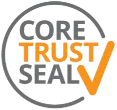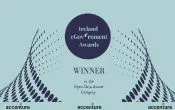Rebecca Grant, Digital Archivist at DRI, discusses the process of developing guidelines for ISAD(G) and EAD
Developing guidelines for ISAD(G) and Encoded Archival Description
Rebecca Grant, DRI Digital Archivist
 We at the DRI are very pleased to launch our newest set of guidelines, EAD, ISAD(G) and the Digital Repository of Ireland. These are the latest in our series of metadata guidelines which currently includes Dublin Core, Qualified Dublin Core and MODS. The guidelines aim to provide accessible, straightforward instructions on creating metadata which is compatible with the DRI, as well as conforming to the relevant metadata standards.
We at the DRI are very pleased to launch our newest set of guidelines, EAD, ISAD(G) and the Digital Repository of Ireland. These are the latest in our series of metadata guidelines which currently includes Dublin Core, Qualified Dublin Core and MODS. The guidelines aim to provide accessible, straightforward instructions on creating metadata which is compatible with the DRI, as well as conforming to the relevant metadata standards.
ISAD(G) is the descriptive standard used to create finding aids for archival collections, while EAD is the XML standard which encodes it. Our requirements interviews and subsequent report Digital Archiving in Ireland identified ISAD(G) and EAD as the second most prevalent metadata standards used in Irish organisations, along with Dublin Core, MODS and MARC. As the Repository encourages the deposit of data from a range of stakeholders including libraries, archives, museums, galleries and research projects, we decided that it was important that the relevant metadata standards from each domain were supported. This involved a two-stage process, firstly developing our requirements for each standard which include mandatory and recommended elements, and suggested controlled vocabularies. We then had to cross-walk the elements from each standard to ensure that the same type of information was presented to users in the Repository’s front-end, allowing the digital objects to be easily searched, browsed and interpreted.
The process of mapping these equivalent elements was one of the biggest challenges in our implementation of EAD. Once we had decided which information would be required to accompany each digital asset in the Repository (for example a creator, a title, a description, a date) we needed to identify which element in the metadata standards captured this information. We could then map them so that they could be indexed together for search in the back-end, and displayed consistently in the front-end.
Although it seemed initially that this would be reasonably straightforward, the process involved months of work by our Metadata Taskforce, including research, lengthy discussion, and consultation with international experts. As an example, “description” was mandatory information which we decided would be required for each digital asset, and in Dublin Core, this is captured in the <dc:description> element. It appeared that <ead:scopecontent> (Scope and Content) would be the obvious mapping for this element in EAD. However with digital collections, it is possible for descriptive information to be captured in <ead:daodesc> (Digital Archival Object Description); and some cataloguers also include this information in <ead:abstract>. This meant that we mapped three elements into our “description” field in the user interface, and we now consider EAD–XML files to be compliant with DRI as long as they use any one of these three.
As archival cataloguers know, EAD and ISAD(G) are hierarchical standards, presenting each archival object in its context and describing the material from the collection or fonds level, down to item level, with the possibility of adding multiple series or file-level descriptions in between. As descriptions move from the general to the specific, archival cataloguers are not expected to repeat information at lower levels if it has already been given at a higher level. However, the Repository requires mandatory elements to be included for every collection, sub-collection and object being ingested. We did not want our requirements to mean that archives would need to catalogue their material in a way which was at odds with their normal practice, or which contradicted the ISAD(G) or EAD standards. In order to overcome this, the system was designed to ingest EAD-XML which had DRI’s mandatory elements present at collection or fonds level, with the levels below inheriting the same information. For example, a creator’s name entered in <ead:origination> at collection level will populate the creator field for every object in that collection in the Repository’s user interface, without requiring the cataloguer to enter it multiple times. If an object at a lower level has a different creator to the main collection and the cataloguer adds their name to the appropriate level, that name will display instead.
Aside from the mandatory elements which we required for DRI, ISAD(G) and EAD have their own requirements which we needed to incorporate into our guidelines, even though they didn’t necessarily map to elements in our other chosen metadata standards. For example Level of Description (<archdesc> with LEVEL attribute) and Reference Code(s) (<unitid> with IDENTIFIER attribute) are mandatory for ingestion into the Repository, but are not cross-walked elements which we had chosen to display in our user interface. To address this, all of the EAD elements which are ingested (including optional elements like <ead:arrangement> or <ead:originalsloc>) are displayed to the user when they select “Full Metadata” when viewing an object. This allows cataloguers to include all of the relevant elements for their collections, while maintaining a streamlined user-interface for each record.
EAD can be flexible, for example allowing cataloguers to enhance their records by marking up descriptive text within a range of elements – such as indicating an <ead:name> within <ead:unittitle> or <ead:scopecontent><p>. This kind of flexibility is useful for cataloguing, but required decisions to be made about mappings and presentation of data in the Repository for every possible combination of each element.
The publication of the DRI’s guidelines on ISAD(G) and EAD is intended to aid cataloguers in preparing metadata for ingestion into DRI. However we also hope that the guidelines are straightforward and user-friendly enough that they will be more generally useful to Irish archives wishing to catalogue using these standards. The production of the guidelines was extremely complex and time consuming, and couldn’t have been achieved without the input of our DRI Metadata Taskforce and international experts; however special thanks must be given to Agustina Martínez-García, Dolores Grant and Kathryn Cassidy for their work in ensuring that our recommendations aligned with EAD, ISAD(G), and the data models developed in the Repository. Despite the complexity of implementing these standards for DRI, the work proved stimulating as well as intellectually challenging for the team. Given that a new version, EAD3, was published by the Library of Congress in 2015, it is possible that this challenge will be repeated sooner than we had anticipated!
To read more entries in the DRI blog, please visit the Blog Page.





